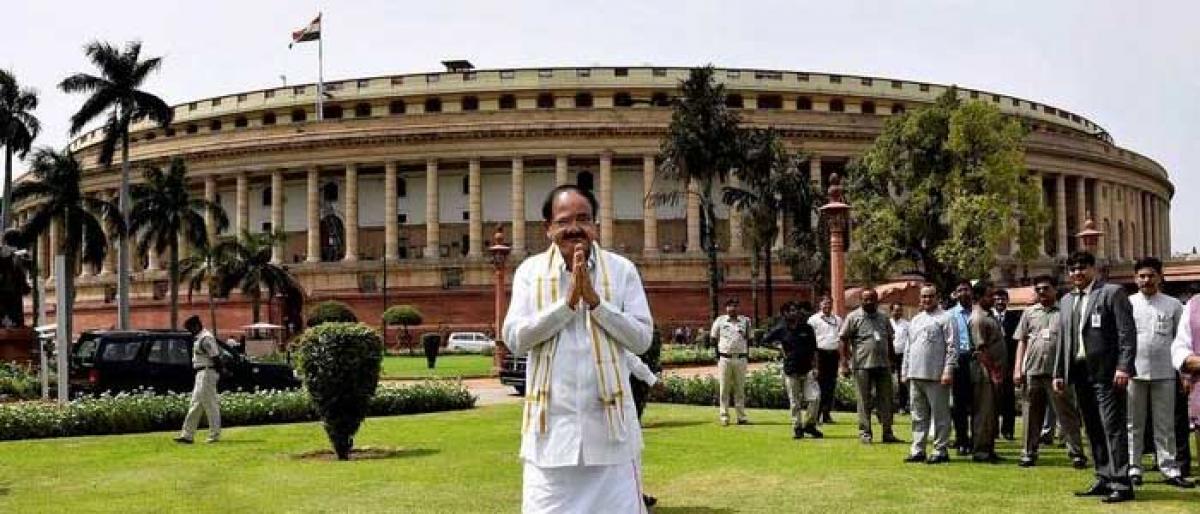Live
- Esports Mania Grips India: What are the Trends Fueling this Growth?
- AI-Powered CRM: Shaping the Future of Customer Relationship Management
- AI and Fraud Prevention in Pharmacy: Fayazoddin Mohamad’s Vision for a Safer Industry
- Google Gemini Prepares for a Smarter AI Era
- The Future of Healthcare: Bharath Kumar Kakkireni on Transforming Patient Care with Innovative Solutions
- We expected better results in Maha polls: Congress
- Jana Sena Party Celebrates Sathya Sai Baba's 99th Birthday with Community Service Initiatives
- Jana Sena Party Celebrates Sathya Sai Baba's 99th Birthday with Community Service Initiatives
- Experience the Best Human Hair Extensions with Gemeria
- Advanced F&O strategies for experienced investors - Straddles, strangles, Iron condors
Just In

Rajya Sabha has a new chairman. M Venkaiah Naidu, as an opposition member described is certainly ‘Now All Indians Dearest Umpire’. His versatile parliamentary experience and distinguished public life would ensure renewed vigour to the functioning of the upper house. But, the need of the hour is to reassert the role of the second chamber of Indian Parliament by recasting the House of Elders.
Rajya Sabha has a new chairman. M Venkaiah Naidu, as an opposition member described is certainly ‘Now All Indians Dearest Umpire’. His versatile parliamentary experience and distinguished public life would ensure renewed vigour to the functioning of the upper house. But, the need of the hour is to reassert the role of the second chamber of Indian Parliament by recasting the House of Elders.
Upper houses are meant for incisive scrutiny of the functioning of executive. Rajya Sabha constitutionally envisioned as the Council of States has the responsibility of zealously guarding the federal character of Indian polity. At a time when the unitary features are being subtracted, this role of Rajya Sabha becomes much more imperative.
But, upper houses are turning into political rehabilitation centres and battle ground for politics between the treasury and opposition benches. Such alteration of the Upper House has raised the questions over the utility of Rajya Sabha.
The bicameral character of Indian Parliament was aimed at resisting centralising tendencies of the federal government as Rajya Sabha represents the States. The Upper House also provides for nominated members from different walks of life who otherwise cannot be drawn into Parliament due to electoral dynamics.
Rajya Sabha is also expected to closely study the bills passed by Lok Sabha where partisan interests dominate. The time has come to revisit whether Rajya Sabha realised these objectives for which it was constituted.
Rajya Sabha is primarily meant for preventing hasty drafting of bills by Lok Sabha. But, politics often makes it an impediment in the process of House of People discharging its constitutional responsibility of representing the popular mandate.
On the other hand, the Executive is resorting to tactics like naming the bill as money bill to escape the scrutiny of Rajya Sabha. This deprives the Upper House of discharging even the limited power the Constitution has given it.
Even the constitutional mechanism like joint sitting of both houses of Parliament is used to thwart the functioning of Rajya Sabha.
As political theorist, Harold Laski observed Upper House is useful if it serves two basic purposes: If it consists of statesmen of experience and standing; if the debates in it become more precious and lively enabling meticulous consideration of pros and cons of every issue.
Rajya Sabha was constituted by borrowing the best features in democracies like Ireland, Britain, Austria and United Sates. Therefore, the problem is not in its constitution or composition. The prevailing political culture defines its role.
At least certain conventions, traditions and systems should be evolved and respected to make the functioning of Rajya Sabha more effective. This requires political sagacity and magnanimity.
French constitutional framer, Abbe Sieyes observed that if a Second Chamber dissents from the first it is mischievous; if it agrees, it’s superfluous. On the other, British jurist and historian Sir Henry Maine said that almost any kind of Second Chamber is better than none. The dilemma continues.
As George Washington asked, “Why do you pour that coffee into your saucer”? “To cool it” was the reply. Rajya Sabha cannot resemble Lok Sabha. Recast the Upper House to function as a check in the legislative making.

© 2024 Hyderabad Media House Limited/The Hans India. All rights reserved. Powered by hocalwire.com







